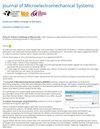Electro-Mechanical Frequency Response of a Piezo-MEMS Speaker Measured by Laser Diode Feedback Interferometry
IF 3.1
3区 工程技术
Q2 ENGINEERING, ELECTRICAL & ELECTRONIC
引用次数: 0
Abstract
Piezo-MEMS speakers based on the inverse piezoelectric effect are becoming increasingly attractive thanks to their low power consumption and are good candidates for miniaturized devices for in-ear audio systems. In this work, we report the use of laser diode feedback interferometry, or self-mixing interferometry, for analyzing the out-of-plane vibration performance of a commercial piezo-MEMS speaker. The photodetected signal provided by the monitor photodiode contained in the laser package was acquired in the frequency domain in the band 0 – 25.6 kHz to analyze the electro-mechanical spectral response of the piezo-MEMS, under conditions of small displacements, by driving it with electrical white noise. Two resonances were detected, one at激光二极管反馈干涉测量压电mems扬声器的机电频率响应
基于逆压电效应的压电- mems扬声器由于其低功耗和入耳式音频系统小型化器件的良好候选而变得越来越有吸引力。在这项工作中,我们报告了使用激光二极管反馈干涉测量法或自混合干涉测量法来分析商用压电mems扬声器的面外振动性能。在0 ~ 25.6 kHz频域范围内采集激光封装中光电二极管提供的光电检测信号,利用电白噪声驱动压电mems,分析其在小位移条件下的机电谱响应。检测到两个共振,一个在$\ \约2.8$ kHz处,质量因子Q较低,符合器件规格;另一个在$\ \约21.4$ kHz处,略高于人类可听频率范围,具有较高的Q。为了获得位移灵敏度,用不同频率和幅值的正弦信号驱动MEMS。在时域中获取光检测信号,用于恢复膜片位移幅度和相位延迟。特别是,我们能够突出高q共振在高应力和大位移条件下的非线性频谱响应,并重建向上和向下扫频的滞回周期。通过我们极其紧凑和低成本的干涉测量配置检测到的机电频率响应提供了扬声器振动性能的完整概述,这对于电声表征之前的初步调查非常有用。(2024 - 0204)
本文章由计算机程序翻译,如有差异,请以英文原文为准。
求助全文
约1分钟内获得全文
求助全文
来源期刊

Journal of Microelectromechanical Systems
工程技术-工程:电子与电气
CiteScore
6.20
自引率
7.40%
发文量
115
审稿时长
7.5 months
期刊介绍:
The topics of interest include, but are not limited to: devices ranging in size from microns to millimeters, IC-compatible fabrication techniques, other fabrication techniques, measurement of micro phenomena, theoretical results, new materials and designs, micro actuators, micro robots, micro batteries, bearings, wear, reliability, electrical interconnections, micro telemanipulation, and standards appropriate to MEMS. Application examples and application oriented devices in fluidics, optics, bio-medical engineering, etc., are also of central interest.
 求助内容:
求助内容: 应助结果提醒方式:
应助结果提醒方式:


